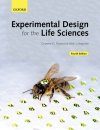Textbook Handbook / Manual
By: Graeme D Ruxton(Author), Nick Colegrave(Author)
202 pages, 35 b/w illustrations
![Experimental Design for the Life Sciences Experimental Design for the Life Sciences]()
Click to have a closer look
About this book
Contents
Customer reviews
Related titles
About this book
The careful design of experiments lies at the core of good research. Experimental Design for the Life Sciences equips you with the skills you need to effectively design experiments, making this essential aspect of the research process readily understandable. It demonstrates how good experimental design relies on clear thinking and biological understanding, not mathematical or statistical complexity.
With a refreshingly approachable and articulate style, Experimental Design for the Life Sciences walks you through the considerations that go into designing an experiment in clear, practical terms. Using examples drawn from across the life sciences – from ecology, biochemistry, molecular biology, genetics, and health sciences – the authors illustrate how these concepts are applied within the broad context of real biological research.
New to this edition
- New chapters dedicated to key concepts such as pseudoreplication, statistical power, and different types of design.
- Completely reorganized structure, which emphasizes how the features of a particular biological question of interest will naturally draw you to different types of design and of data analysis.
- Updated examples drawn from across the life sciences.
- Enhanced Online Resource Centre, with additional examples, supplementary sections on complex concepts and statistical issues, and suggested course structures with practical exercises.
Online Resource Centre
The Online Resource centre to accompany Experimental Design for the Life Sciences features:
For students:
- Self-test questions and answers
- Additional examples
- Supplementary sections discuss complex concepts and statistical issues in more depth
- Links to useful websites and free software
For lecturers:
- Suggested course structures, complete with practical exercises
Contents
1: Why you should care about design
2: Starting with a well-defined hypothesis
3: Selecting the broad design of your study
4: Between-individual variation, replication, and sampling
5: Pseudoreplication
6: Sample size, power, and efficient design
7: The simplest type of experimental design: completely randomized single-factor
8: Experiments with several factors (factorial designs)
9: Beyond complete randomization: blocking and covariates
10: Within-subject designs
11: Taking measurements
Customer Reviews
Textbook Handbook / Manual
By: Graeme D Ruxton(Author), Nick Colegrave(Author)
202 pages, 35 b/w illustrations
Reviews from previous editions:
"I think it is splendid; it is the sort of short and concise text which students remember for a long time and which they hang on to long after the course is passed."
– Bernt Walther, Department of Fisheries and Marine Biology, University of Bergen
"I would have loved to have such a book in this phase of my scientific career."
– Mariet Hefting, Institute of Environmental Biology, Utrecht University
"A well-presented, clearly argued, concise and witty introduction to one of the most important topics in the life sciences."
– Nick Royle, School of Biosciences, Exeter University
"At last a text which clearly and comprehensively takes the student through the mechanisms of sound practice and the pitfalls of less sound experimental design in the biological sciences. Although aimed directly at the undergraduate life sciences student it would also be useful to those studying both above and below this level."
– Journal of Biological Education, Autumn 2006
"This is an excellent book for learning how to approach the design of experimental and, indeed, observational work. It avoids the usual inclusion of statistical detail that turns many students off while retaining all the key issues that are necessary for planning studies that produce good science. I commend this book to all those who struggle to get students to think seriously about designing good scientific studies."
– Higher Education Academy, Bioscience e-Journal, June 2006


































